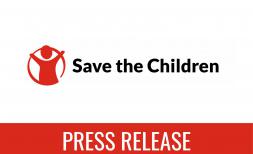Hunger levels soar in Horn of Africa as region faces driest summer in over 35 years

Save the Children warned of a major emergency in the Horn of Africa, as nearly 13 million people face critical levels of hunger following a succession of failed rains. Half of the affected people, an estimated 6.5 million, are children. The region is now experiencing the lowest cumulative rainfall totals since 19811.
Despite efforts by aid agencies and the governments of Ethiopia, Somalia and Kenya, the hunger situation in the Horn of Africa is rapidly deteriorating, with fears families might soon face an even worse situation than the food crisis of 2017. Although the number of food insecure people across the Horn of Africa is currently lower than at the height of the 2016 -17 drought, the situation looks set to deteriorate with drought anticipated in the coming months2. Somalia has already seen an increase of 36% of food insecure people compared to late 20183.
Save the Children’s teams on the ground are seeing communities struggling to regenerate pastures, replenish water supplies and restore livestock herds, fuelling displacement and forcing families to seek out new livelihoods.
Between January and May 2019 alone, an estimated 59,000 people were displaced in Somalia as a result of drought4. In June 2019, across the Horn of Africa the total number was an estimated 1.8 million people that fled drought5. These families are among the 11.6 million people that had to leave their homes in the East and Horn of Africa as the result of drought, floods, and conflict6.
Children are suffering disproportionally, with the agency gravely concerned of the risk of spiking malnutrition. Malnutrition as a result of food insecurity is one of the biggest risks for children under five, with severely wasted children 11 times more likely to die than those with a healthy weight. Undernourished children also catch infections more easily and have a harder time recovering because or weakened immune systems7.
- In Kenya, an estimated 2.6 million people face acute food insecurity and are in need of humanitarian assistance. Another 6.8 million are one step away from reaching crisis levels of food insecurity. Across the country, over 600,000 children already require treatment for malnutrition8.
- In Somalia, 2.1 million people face critical food shortages and require humanitarian support to meet their basic food needs, and an additional 4.2 million people are on the verge of critical shortages. More than one million children under the age of five are at risk of acute malnutrition. The current food crisis in has led to acute levels in most parts of the country. At least 178,400 children are facing severe malnourishment9.
- In Ethiopia, 8.1 million people are in need of food assistance and there are growing fears that these numbers will continue to grow with the upcoming post-rains assessment due to take place in December 10. Save the Children, through its household economic analysis project, has been closely working with the Government of Ethiopia to assess the level of needs at the household level and will continue to do so.
Save the Children’s Regional Director in East and Southern Africa, Ian Vale, said the international community must step up now to avert mass displacement and loss of life.
“Over the past year we have repeatedly called for a dramatic increase in funding, and to date this has largely fallen on deaf ears. As a result, children are facing hunger now. Across the Horn of Africa, Save the Children needs an additional 100 million dollars to meet people’s daily nutritional requirements, lifesaving health provision as well as bolster systems to support them to adapt to their climate-affected world.
“The current funding gap and the failure of the international community to step up have created the conditions for this region-wide emergency. While national governments are working hard to respond to the needs, we fear the situation will only get worse in coming months, with the upcoming El Nino weather event likely resulting in another massive spike in the number of malnourished children.
“The impact of climate change on the lives of Ethiopians, Kenyans and Somalis is becoming more intense every year. We cannot expect children and their families in this poverty-stricken region to bear the impact of the climate crisis. This is a global issue, and we have a global responsibility to support the most vulnerable.”
Across the Horn of Africa, Save the Children is implementing resilience programs to address the longer-term impacts of climate change. In Somalia, Save the Children is supporting the establishment and training of community-based disaster management committees who can develop their own plans and strategies to adapt to disasters according to their local needs and contexts.
In Ethiopia, Save the Children supports unemployed young ‘pastoralist drop-outs’ who were forced by the circumstances to give up the cattle farmer trade. Save the Children works to get them a training that suits their interests and skills, and that will give them sustainable incomes in the future. In Kenya, we are supporting women-led loans and savings groups, so families can start small scale businesses, run sustainable kitchen gardens, and raise livestock appropriate for drought-conditions.
[1] [2] United Nations [June 2019] Horn of Africa: A joint call for action before a major regional humanitarian crisis https://reliefweb.int/sites/reliefweb.int/files/resources/HoA%20Joint%20Position%20Paper%20FAO%20UNICEF%20WFP%20Final.pdf
[3] SOMALIA Humanitarian Dashboard - August 2019 [As of 1 October 2019] https://reliefweb.int/sites/reliefweb.int/files/resources/Somalia%20Humanitarian%20Dashboard_Aug%202019%20%5BRecovered%5D.pdf
[4] Between January and May, UNHCR estimated about 162,000 displacements in Somalia caused by insecurity (56%), drought (37%) and floods (3%). https://reliefweb.int/sites/reliefweb.int/files/resources/Midyear%20trends%20report%20January%20to%20June%202019%20FOR%20PREVIEW.pdf
[5] [Including Uganda] UNOCHA Horn of Africa Drought Snapshot [June 2019]
[6] As of June 2019, the East and Horn of Africa region recorded 8.1 million internally displaced persons (IDPs) and 3.5 million refugees and asylum-seekers. IOM Mid-Year Mobility Snapshot January to June 2019
[7] WHO Malnutrition in Emergencies [2017]
[8] Government of Kenya 2019 LONG RAINS SEASON ASSESSMENT REPORT [August 2019] KENYA NUTRITION SITUATION OVERVIEW ARID AND SEMI-ARID AREAS [JULY 2019]
[9] Post Gu FSNAU FEWS-NET Technical Release [1 September 2019];
[10] 2019 Ethiopia Humanitarian Needs Overview, OCHA Situation Report for Ethiopia June 2019




